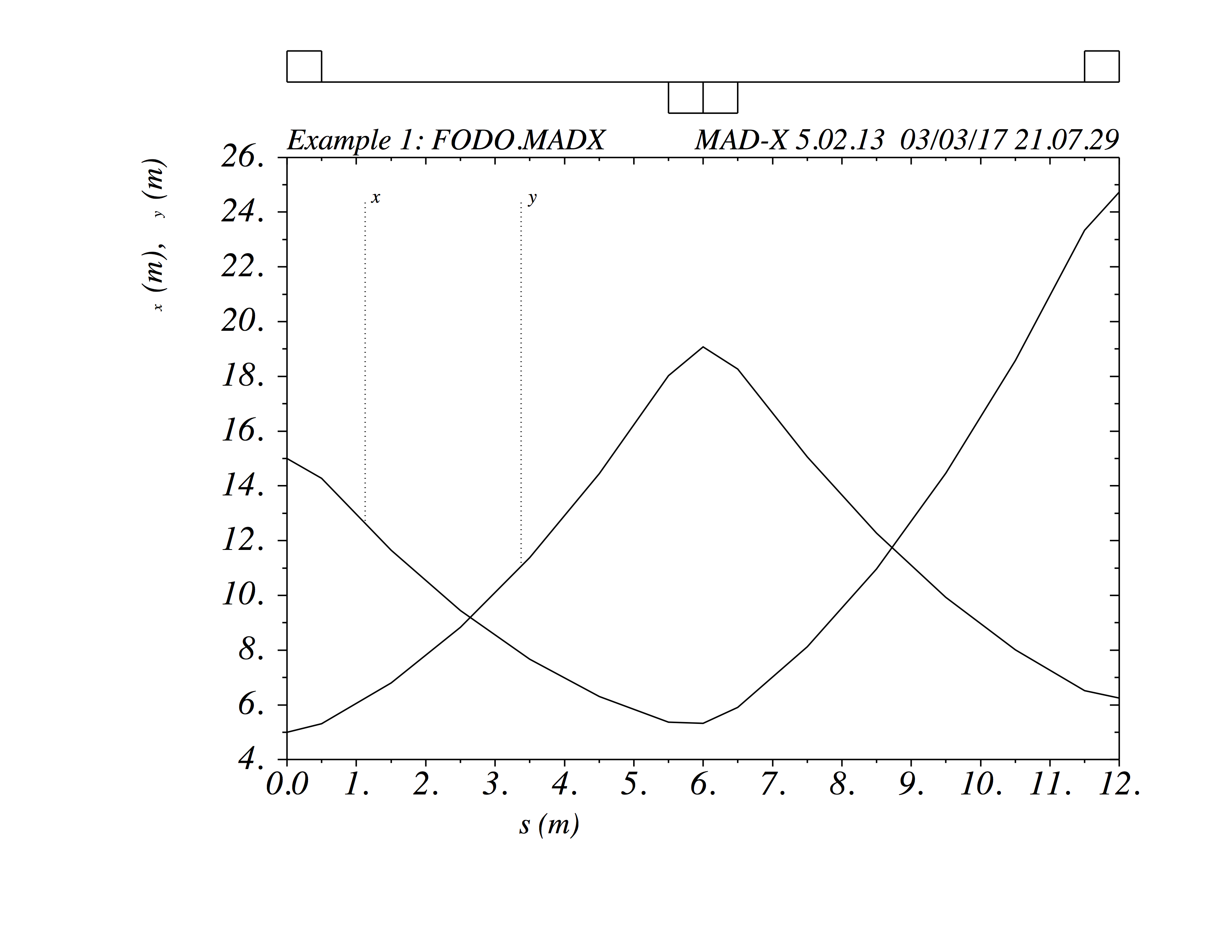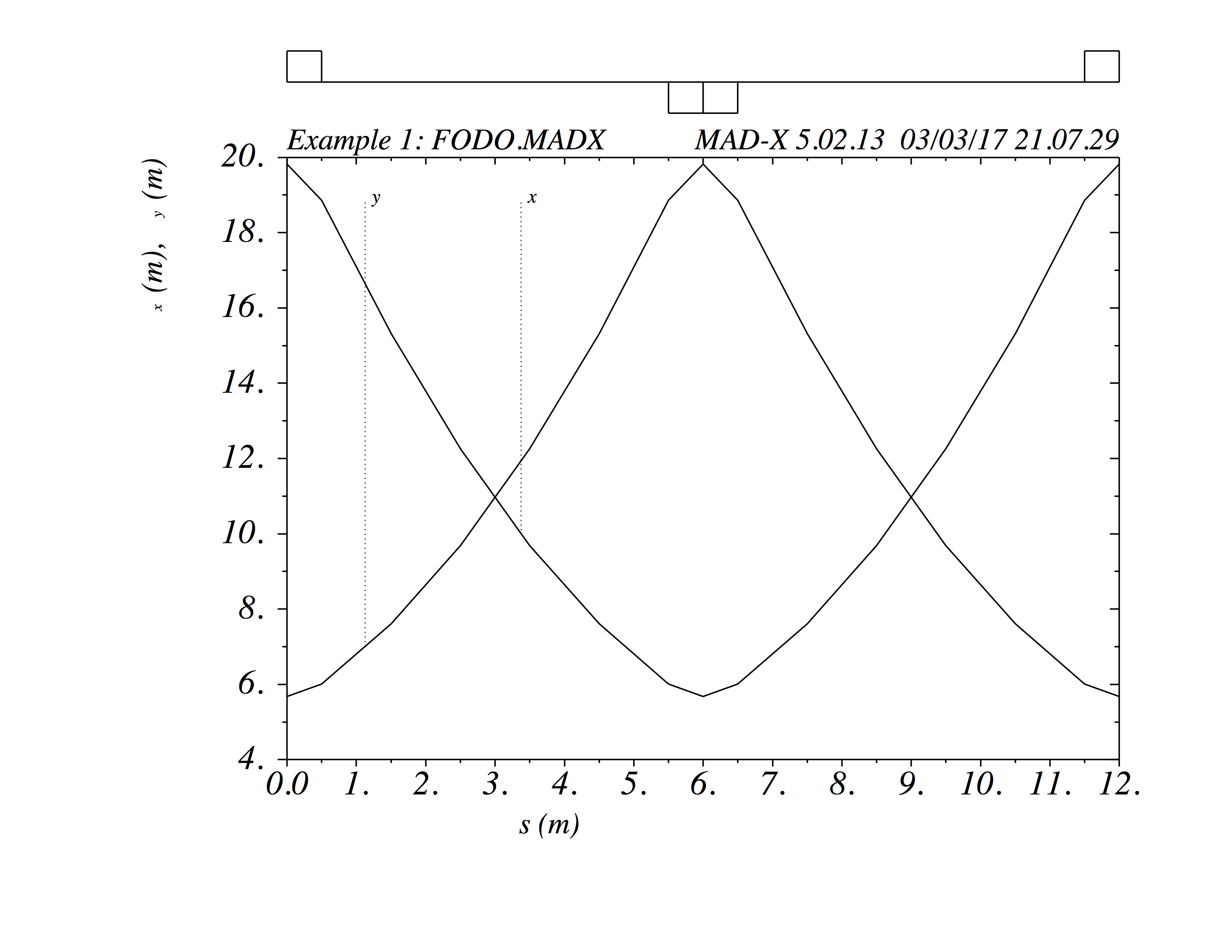B Using MAD-X
The Methodical Accelerator Design code (MAD) is a single-particle dynamics code which is extensively used for the design and optimization of systems of electromagnetic fields for beam lines and storage rings, most typically those used in high-energy applications. After the 8-th version of MAD, the next version – known as “X” – saw a re-vamping of the major code; since that time the code has been known as MAD-X. While MAD-X is not the best code for every job, it is a must for anyone that may have the need for doing basic layout, design, and optimization of optics and for doing basic particle tracking and sensitivity analyses of beam lines, synchrotrons, storage rings, etc, with its superior fitting and optimization routines. MAD or MAD-X has been used for the design and analysis of almost all major accelerators and beam lines at CERN, Fermilab, numerous light sources and many other major facilities since its introduction in the late 1980’s.
Below we describe briefly where to obtain and download MAD-X to your computer, how to run the code, and give a brief example of a typical MAD calculation.
B.1 Downloading MAD-X
MAD-X runs on Linux, Mac, and PC systems. It can be downloaded from the MAD-X web site:
On the site, go to the Releases sub-page to choose the development or production release that you would like to install on your computer. The following instructions assume that you have downloaded the 64 bit development release from the development release repository and placed it in a desired directory. From that directory:
B.1.1 On Linux (all distributions)
In a terminal, execute the commands:
mv madx-linux64 madx
- renames the file
madx-linux64tomadx
chmod u+x madx
- changes the permissions for the executable file
madx
./madx
- runs the executable file
madx
B.1.2 On MacOSX (starting from Leopard)
In a terminal, execute the commands:
mv madx-macosx64 madx
- renames the file
madx-macosx64tomadx
chmod u+x madx
- changes the permissions for the executable file
madx
./madx
- runs the executable file
madx
B.1.3 On Windows (starting from Windows XP)
In a terminal, execute the commands:
move madx-win64.exe madx.exe
- renames the file
madx-win64.exetomadx.exe
./madx.exe
- runs the executable file
madx.exe
B.2 Running MAD-X
By running the executable files as described above (./madx from a Mac console, for instance) MAD-X will accept MAD commands from the terminal and perform calculations and generate output. A more typical process is to edit a text file that contains MAD commands and then submit that file for execution by MAD:
edit the ASCII text file lattice.madx and then (from a Mac, for instance),
./madx lattice.madx
The user should download the pdf MAD-X Users’ Guide from the Documentation tab on the MAD-X web page. This web page also contains example input files as well as tutorials and a primer for learning the basics of the MAD envrionment.
B.3 MAD-X Example
Here is an input file of a MAD calculation wherein
- a simple FODO lattice is input,
- some initial values for \(\beta_x\) and \(\beta_y\) are given (\(\alpha\)’s are zero, by default),
- the Courant-Snyder (Twiss) parameters are computed at the end of each element starting with the initial values,
- a plot of the amplitude functions \(\beta_x\) and \(\beta_y\) is created,
- the periodic Courant-Snyder (Twiss) parameters are found (
MATCH), - the periodic Courant-Snyder parameters are computed,
- a plot of the periodic functions are made, and
- a table of summary parameters of the calculation is written to a file
edit a text file, titling it fodo.madx:
TITLE, 'Example 1: FODO.MADX';
BEAM, PARTICLE=ELECTRON,PC=3.0;
D: DRIFT, L=1.0;
QF: QUADRUPOLE, L=0.5,K1=0.2;
QD: QUADRUPOLE, L=0.5,K1=-0.2;
FODO: LINE=(QF,5*(D),QD,QD,5*(D),QF);
USE, PERIOD=FODO;
TWISS,SAVE,BETX=15.0,BETY=5.0;
PLOT,HAXIS=S, VAXIS=BETX, BETY;
MATCH, SEQUENCE=FODO;
TWISS, SAVE;
PLOT,HAXIS=S, VAXIS=BETX, BETY;
Value, TABLE(SUMM,Q1);
Value, TABLE(SUMM,Q2);
WRITE,TABLE=SUMM,FILE=FODO.txt;Upon executing this file (./madx fodo.madx) an output file fodo.txt is produced, as well as a postcript file madx.ps. These will contain:
fodo.txt:
@ NAME %04s "SUMM"
@ TYPE %04s "SUMM"
@ TITLE %20s "Example 1: FODO.MADX"
@ ORIGIN %17s "5.02.13 Darwin 64"
@ DATE %08s "03/03/17"
@ TIME %08s "21.07.29"
* LENGTH ORBIT5 ALFA GAMMATR Q1 DQ1 BETXMAX DXMAX DXRMS XCOMAX XCORMS Q2 DQ2 BETYMAX DYMAX DYRMS YCOMAX YCORMS DELTAP SYNCH_1 SYNCH_2 SYNCH_3 SYNCH_4 SYNCH_5 NFLIPS
$ %le %le %le %le %le %le %le %le %le %le %le %le %le %le %le %le %le %le %le %le %le %le %le %le %le
12 -0 0 0 0.1913459932 -0.2182118039 19.81848928 0 0 0 0 0.1913459932 -0.2182118039 19.81848928 -0 0 0 0 0 0 0 0 0 0 0madx.ps (when converted to pdf) contains two images:

MAD output 1

MAD output 2
Naturally, MAD-X provides many options for adjusting plots, creating custom tables of output, performing particle tracking, and much more.